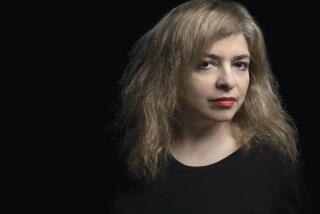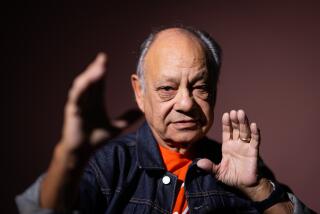LATIN QUARTERS
THE VENICE HOME OF ENRIQUE MART’NEZ CELAYA ays as much about the artist’s past as it does about his present life. “I look at my house as one more aspect of my work,” says Mart’nez Celaya of the former art gallery. “I wanted the house to reflect my own personal sensibilities: a mixture of minimalism, which I love, but also my Spanish heritage.”
Hidden behind the sleek, white facade of the two-story building, the home features a modern hacienda interior with tiled courtyards, shuttered windows and wrought-iron gates. A stained-glass church window in his office tints the floor red in the late-afternoon light. Outside his studio is a courtyard with lime trees and a small balcony with red and yellow rose bushes that remind him of his grandmother’s flowers in Cuba. The family left their homeland when Mart’nez Celaya was 8 to live in Spain. His work is imbued with a sense of loss-- haunting images of birds and hands, sculptures of large plaster heads with emotive eyes.
“I wanted a courtyard to lead into the house to soften traffic noises of the busy street and to allow in air and light,” says Mart’nez Celaya, whose work was recently featured in an exhibition called “The Next Wave” at the California Center for the Arts. “I also wanted to create the quiet, light-filled atmosphere I played in as a child.”
A stairway off the front hall leads directly to the second-floor studio and bedrooms. Four skylights in the studio filter diffused light through acrylic floor panels to the open-plan living areas below. Throughout the house, the artist employed a simple palette of natural materials: sisal and Saltillo tiles, wrought iron and rusted steel, plywood and oak. “I didn’t want anything overworked--no curlicues, no gold or silver finishes. Sometimes you walk inside a house where each item calls attention to itself and the house becomes about those items rather than the people who live inside.”
The minimally furnished rooms contain a mix of vintage upholstery, art and Mediterranean-inspired tables that Mart’nez Celaya designed. “I’m not into imitating Spanish style but at creating an eclectic sensibility. I’m interested in the interaction between the raw 17th century colonial legs of a Christ figure and the soft legs of a late-19th century Victorian lamp, or a ‘30s ottoman with a Tuscan dining table. I don’t care about a predescribed idea of decor, but about the way things interact to reveal something new.” For example, the simple living room features ornate mother-of-pearl doors hanging on a wall next to an empty coffee table. “I like the idea of having breathing room for details to resonate--both in my rooms and in my paintings.” He describes a series of recent works in which a detail of a tree in wax and oil paint stands out against a simple black velvet surface. The paintings, for his upcoming fall show at Galeria Ramis Barquet in New York, are based on Schubert’s song cycle “Die Winterreise.”
Then there’s the poetry of the home, the way it feels to the owner. “For most people, when you hear the word ‘poetry’ it means flowery, romantic things. I like the German philosopher Martin Heidegger’s description of poetry as the foundation of truth . . . those relationships that suggest something clear about reality.” Mart’nez Celaya finds poetry in the relationship between a large, sculpted head sitting on the floor next to a painting of a bird surrounded by rose petals. “There is no other reason but an emotional connection for these two pieces to be together.”
What Inspires Enrique Mart’nez Celaya
Any poem by Jorge Luis Borges.
Paul Celan’s “Atemwende.”
Architect Louis Kahn.
Leonardo da Vinci.
Giorgione’s paintings.
Berlin and Havana.
More to Read
The biggest entertainment stories
Get our big stories about Hollywood, film, television, music, arts, culture and more right in your inbox as soon as they publish.
You may occasionally receive promotional content from the Los Angeles Times.










